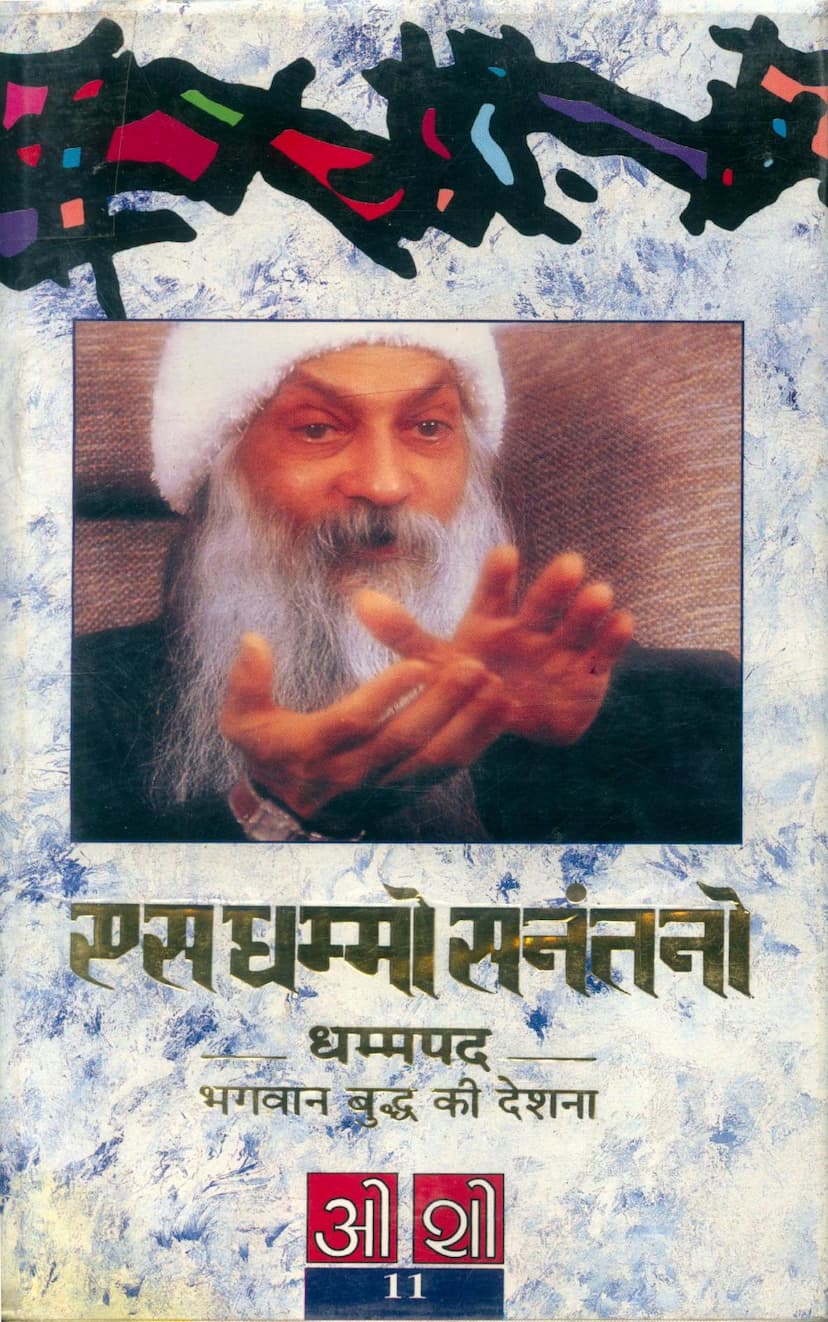Dhammapada 11
Added to library: September 1, 2025

Summary
This comprehensive summary synthesizes the key themes and teachings from Osho's "Dhammapada Book 11: Es Dhammo Sanantano," as presented in the provided Hindi text. The book is a collection of Osho's discourses on Lord Buddha's Dhammapada, focusing on various aspects of Buddhist philosophy and practice.
Central Theme: The Eternal Dharma (Es Dhammo Sanantano)
Osho emphasizes that the core of Buddha's teaching is the "eternal dharma" – the fundamental principles of existence that are unchanging and ever-present. This eternal dharma is not tied to specific doctrines or rituals but is discovered through inner experience and awareness.
Key Concepts and Teachings:
-
The Nature of Reality: Impermanence and Suffering:
- Osho reiterates Buddha's emphasis on the impermanent nature of all phenomena. Life is like a bubble, constantly changing and fleeting. This understanding is crucial for liberation.
- Trishna (Craving/Thirst): The Root of Suffering: The text delves deeply into trishna (craving), identifying it as the root cause of all suffering. Osho explains that craving arises from the desire for things to be different from what they are, a resistance to the natural flow of life. This resistance creates attachment and subsequent suffering when impermanent things inevitably change or disappear.
- The Illusion of Permanence: The human tendency to seek permanence in an impermanent world is highlighted as a fundamental delusion. Whether it's youth, health, relationships, or possessions, clinging to them inevitably leads to pain when they fade.
-
The Path to Liberation: Awareness and Acceptance:
- Awareness (Prajna/Buddha-consciousness): The path to liberation lies in prajna – awareness, mindfulness, and conscious living. By being fully present and aware of the unfolding reality, one can see through the illusions of permanence and craving.
- Acceptance (Tathata): Embracing life as it is, without resistance or desire for it to be different, is central. Accepting impermanence, change, and the natural unfolding of events dissolves craving and its resultant suffering. This acceptance is termed tathata.
- Shattering the Illusion of Self: Osho stresses that the illusion of a permanent, separate self is a major source of suffering. True liberation comes from realizing the interconnectedness and impermanence of all things, including the self.
-
Critique of Ritualism and External Seeking:
- Osho cautions against seeking spiritual fulfillment through external means, rituals, or clinging to past doctrines without inner realization. He stresses that true understanding and liberation come from within.
- The Danger of Attachment to "The Good": He points out that even attachment to "good" things, like the desire for liberation or spiritual attainment, can become another form of trishna. The true path is to be free from all cravings, including spiritual ones.
-
Buddha's Teachings as a Living Experience:
- Osho emphasizes that Buddha's teachings are not static historical events but a living, dynamic force that can be experienced in the present. He reinterprets and contextualizes Buddha's words for the modern age, integrating insights from psychology (Freud), sociology (Marx), and physics (Einstein) to make them relevant.
- The Dhammapada Reborn: This particular work is presented as a "rebirth" of the Dhammapada, infused with Osho's unique insights and language, making Buddha's ancient wisdom accessible and vibrant for contemporary seekers.
-
The Metaphor of the Golden Fish:
- A significant narrative within the discourses is the story of the golden fish caught by fishermen. This fish, with a golden body but a foul-smelling mouth, symbolizes the duality of external attractiveness and internal corruption. It represents how material wealth or superficial appearances often mask inner decay and suffering caused by unaddressed desires and attachments.
-
The Nature of Enlightenment:
- Enlightenment is presented not as an achievement but as an unfolding of one's inherent nature. It is the realization of one's true self, which is beyond duality and suffering.
- The Role of the Guru: While Osho acknowledges the value of a guide (guru), he emphasizes that the ultimate realization comes from within. A guru can point the way, but the journey must be undertaken by the individual.
-
The Importance of Inner Transformation:
- The core message is the necessity of inner transformation. This involves shedding attachments, cultivating awareness, and understanding the roots of suffering.
- The "Eternal Dharma" is Within: The eternal dharma is not an external entity but the truth of one's own being, realized through introspection and mindful living.
Osho's Approach:
Osho's discourses are characterized by their:
- Psychological Depth: He analyzes human behavior and motivations with psychological insight, connecting spiritual truths to the workings of the mind.
- Poetic Language: His explanations are infused with vivid metaphors, stories, and poetic expressions that make the teachings relatable and profound.
- Direct Experience: He constantly encourages the audience to move beyond intellectual understanding to direct experience and realization.
In essence, Osho's "Dhammapada Book 11" serves as a vibrant exposition of Buddha's timeless wisdom, urging individuals to look within, understand the nature of craving, and cultivate awareness to realize their inherent enlightened nature. The emphasis is on living consciously, accepting the flow of existence, and finding liberation not through external pursuit but through inner transformation.